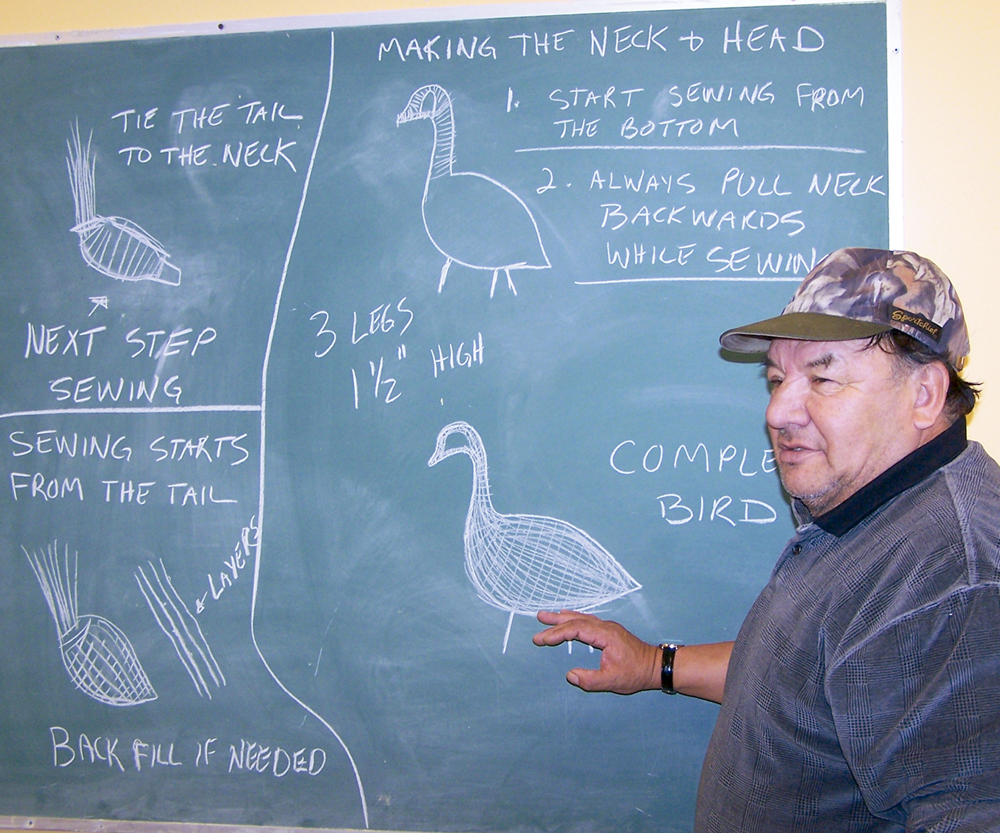
Tamarack decoys, snowshoes, spruce baskets and moose-hide mitts, gloves and slippers are all products that were traditionally made by the Crees but their production has seen a decline since colonization and the intrusion of the modern world.
In an attempt to keep traditional arts and crafts from falling by the wayside the Cree Native Arts and Crafts Association (CNACA) is hard at work researching these traditional wares and teaching the people how to keep the customs alive.
Darryl Hester, who develops and runs the various training programs that the CNACA offers, said, “Our main goal is to revive Cree arts.”
CNACA’s objective is not just about teaching arts and crafts to community members but also researching the history behind these products and reintegrating the traditional tools used to make them in an attempt to piece together every aspect of Cree cultural arts.
“We are in the process of recreating these different arts and crafts that we have lost over time. We are still doing research and not only on the crafts but also on the music and the arts,” said Hester.
Last November, CNACA held its first traditional training for tamarack-decoy making in Waskaganish. The three-week course attracted 15 participants who had the opportunity to reconnect with their cultural past.
The course was taught by Roderick Blackned and his son, Harvey, who was in charge of harvesting of the tamarack branches.
“(Harvey) took the trainees out and showed them which trees to take branches from. If you want to make an actual decoy for goose hunting, you use branches from a darker tree while the lighter branches are used more for decorative decoys,” explained Hester.
“(The participants) made traditional decoys, the ones with the hole in the head. They made ones that look like sitting birds with folded wings, as well as the flying decoys that look like they are about to land,” said Hester.
To make a tamarack decoy, said Hester, “What they do is create a ball, which is the body. Then you lay the longer branches down and place the ball in the middle – this is when the sewing comes in. They sew the decoy into shape. They start from the tail, go into the body area and then the neck and head. When they have shaped it, it should look like a goose. It’s not hard to learn but it takes practice. I even created one when they did the training.”
According to Hester, someone with well-honed skills can make a small tamarack in about two-to-three hours while the larger type, the kind traditionally used for hunting, takes about five or six hours.
The tamarack-making course is just the beginning. Since CNACA began its initiative in August 2004, it has been gathering information on how the crafts were originally made. Now it wants to offer a course on the traditional preparation of moose hide for garments and accessories as well as courses on making spruce baskets, snowshoes and canoe paddles.
CNACA’s intentions are to eventually run the courses year-round so that the crafted products can be made according to the seasons when they were traditionally produced.
“In the fall we hunt moose and get the moose hide and prepare it. In the winter we start scraping and thinning it, depending on how thick or thin we want the hide to be. Then in the spring we do the tanning and the smoking, which is done with a specific tree. And in the summer we do the sewing part. So it’s a yearlong training,” said Hester.
The same tanned moose hide will also be used for the netting in the snowshoes.
To promote CNACA courses and to ensure that they are historically accurate, Hester travels from community to community doing research and gathering information. “We are doing community tours right now which will be ongoing and this is where we will find out about some of the original tools and crafts and how they were done and where they originated. Like the tamarack, it originated from Waskaganish so there are more designers and crafters who make tamaracks in Waskaganish than anywhere else. It’s the same thing with the spruce baskets,” he said.
As the courses are only being taught in Waskaganish, this will require community members who wish to partake in the cultural experience to travel. Funding has been made available to those who wish to take time out for the unique cultural enrichment. “CNACA covers the travel cost and the training fees and there are funding groups that we go to like the CRA, the Grand Council and the Canada Council for the Arts,” said Hester.
Those who take the courses will also have an opportunity to be remunerated for their crafts, should they wish to sell them. As CNACA tours the various trade shows and events where crafts are sold, it has taken several students down to Montreal. The students can connect directly with the customers buying their wares and are allowed to keep the profits. Part of the idea behind this move is that Crees can eventually start their own business selling traditional products to the general public. Eventually CNACA will also be set up to sell the products online.
Though Hester still has a long road ahead of him in terms of getting the courses up and running, CNACA has become his labour of love and his connection to the past.
“It’s about time that we had an organization like this that is preserving, promoting and enhancing the Cree culture, skills and traditions. In the long term, it will be really good. With the generation we have today, it feels like we are losing everything. With all of the (modern) diversions, it’s not like we are losing the land but we have to fight to save our traditions and our culture so I think this is the way to go and that it’s really good,” said Hester.

